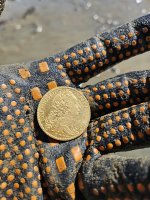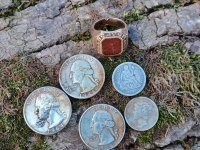Gypsy Heart
Gold Member
On March 15, 1937, Mrs. Marie Carter of Anthony, New Mexico, working for the WPA Writers' Project, submitted the manuscript that follows to the Project in Washington. That manuscript is now archived at the Library of Congress. Mrs. Carter's introduction to her manuscript (written in 1937) follows:
I was talking to a bunch of fellows today. Here are some of the stories I was told.
--------------------------------------------------------------------------------
"You see, lady, I got this story from one of the early settlers, and he got it from a very old Mexican. Along about 1851, when James S. Calhoun the first Governor of New Mexico was in office, Indians were as thick as ants. One bright day six Indians on horses and carrying several boxes of gold were seen up there in the mountains. That was the last seen of them till several years later--then they were dead."
"Were they the same Indians?" I inquired.
"They must have been, for there were exactly six human skeletons and six horse skeletons. Whether they were robbed then murdered, or murdered after they hid the gold, nobody knows. And they weren't certain just how they were murdered, but it wasn't hard to guess.
"For not far away, but scattered in different directions, they found several arrows, which were identified as belonging to the fierce apaches. Well," he said, glancing over his shoulder and starting down the highway, "I'm in an awful hurry. My wife sent me to the grocery two hours ago, and there she comes."
There are several versions of the legend of the six Indians. Some of the old-timers say there were five Indians, and that they carried sacks of gold. James S. Calhoun: First Governor of New Mexico was appointed under the regular territorial government. He was inaugurated as governor on March 5, 1851, and during his term of office had a great deal of trouble with Indian uprisings. At an earlier date, 1849, he was Indian agent for New Mexico. He died in the month of May, 1852, en route to Washington.
--------------------------------------------------------------------------------
"I wonder if any of you know the story of Cimarron Kate?"
"Yep," the man we call Bob took it upon himself to answer. "I've been in her cave and dug around considerable, but I ain't found no cache. She was a woman bandit and the leader of a gang of outlaws. I've been told that she hung around here about 1854. One day she got wind that the Wells Fargo Express was bringin' a big shipment of gold bullion through the valley. Well, her and her gang hid out in the mesquite, and suddenly, swooped down on the express, shot the driver, and took all the gold their broncs could carry."
"Where did they take it?" I asked.
"Well, they was aimin' to get to her cave and had just about reached it when a posse, hot on their heels, opened fire. The bandits returned the fire and kept the posse busy till Kate hid the gold and made her escape. They fought a hot battle and every darn outlaw was killed. The cave is close to the spot where the battle took place, that's why they call it the Cimarron kate cave," he said.
--------------------------------------------------------------------------------
"Judge," I said, turning to a tall man who had just joined us, "I wish you'd give me your version of Doniphan's expedition, and the battle of Brasito, near old Fort Fillmore."
"Is that all?" His eyes twinkling, for I had called on him before.
"No," I confessed. "First I should like to have you tell us what you think of New Mexico and our highway, or U. S. Highway 54."
"As far as climate is concerned, I don't know of another state in the Union that equals New Mexico. It is without doubt a land of enchantment, and they couldn't have given this road a more fitting name than the Broadway of America. For it is a route over which savage tribes and civilized nations have traveled for ages. Look at that." He pointed at the Organ mountains northeast of us.
"Oh, how beautiful!" I exclaimed.
"Perfect coloring," the judge agreed. "Now you know why the western writer, Jean Manlove Rhodes, called the Organs, 'Rainbow Mountains.'"
--------------------------------------------------------------------------------
"Have I ever told you that one about the engineer and the Organs?" "Well, this engineer was one of them big guys from the East. One day he stared at the Organs and said: 'There's a great piece of engineerin' work waitin' up there for some man. If holes were drilled in them pipes at the correct angle, this valley would be flooded with soft, sweet, music, every time the wind blew.'
"Well," Bob continued," I thought that engineer was poco loco (a little crazy). So I said, 'Mister the job's yourn, 'cause I don't know anybody around here with enough energy to turn the trick. Except I recon you don't know how much wind we've got here. I'm afeared we'd get a lot too much pipe music.'"
I was talking to a bunch of fellows today. Here are some of the stories I was told.
--------------------------------------------------------------------------------
"You see, lady, I got this story from one of the early settlers, and he got it from a very old Mexican. Along about 1851, when James S. Calhoun the first Governor of New Mexico was in office, Indians were as thick as ants. One bright day six Indians on horses and carrying several boxes of gold were seen up there in the mountains. That was the last seen of them till several years later--then they were dead."
"Were they the same Indians?" I inquired.
"They must have been, for there were exactly six human skeletons and six horse skeletons. Whether they were robbed then murdered, or murdered after they hid the gold, nobody knows. And they weren't certain just how they were murdered, but it wasn't hard to guess.
"For not far away, but scattered in different directions, they found several arrows, which were identified as belonging to the fierce apaches. Well," he said, glancing over his shoulder and starting down the highway, "I'm in an awful hurry. My wife sent me to the grocery two hours ago, and there she comes."
There are several versions of the legend of the six Indians. Some of the old-timers say there were five Indians, and that they carried sacks of gold. James S. Calhoun: First Governor of New Mexico was appointed under the regular territorial government. He was inaugurated as governor on March 5, 1851, and during his term of office had a great deal of trouble with Indian uprisings. At an earlier date, 1849, he was Indian agent for New Mexico. He died in the month of May, 1852, en route to Washington.
--------------------------------------------------------------------------------
"I wonder if any of you know the story of Cimarron Kate?"
"Yep," the man we call Bob took it upon himself to answer. "I've been in her cave and dug around considerable, but I ain't found no cache. She was a woman bandit and the leader of a gang of outlaws. I've been told that she hung around here about 1854. One day she got wind that the Wells Fargo Express was bringin' a big shipment of gold bullion through the valley. Well, her and her gang hid out in the mesquite, and suddenly, swooped down on the express, shot the driver, and took all the gold their broncs could carry."
"Where did they take it?" I asked.
"Well, they was aimin' to get to her cave and had just about reached it when a posse, hot on their heels, opened fire. The bandits returned the fire and kept the posse busy till Kate hid the gold and made her escape. They fought a hot battle and every darn outlaw was killed. The cave is close to the spot where the battle took place, that's why they call it the Cimarron kate cave," he said.
--------------------------------------------------------------------------------
"Judge," I said, turning to a tall man who had just joined us, "I wish you'd give me your version of Doniphan's expedition, and the battle of Brasito, near old Fort Fillmore."
"Is that all?" His eyes twinkling, for I had called on him before.
"No," I confessed. "First I should like to have you tell us what you think of New Mexico and our highway, or U. S. Highway 54."
"As far as climate is concerned, I don't know of another state in the Union that equals New Mexico. It is without doubt a land of enchantment, and they couldn't have given this road a more fitting name than the Broadway of America. For it is a route over which savage tribes and civilized nations have traveled for ages. Look at that." He pointed at the Organ mountains northeast of us.
"Oh, how beautiful!" I exclaimed.
"Perfect coloring," the judge agreed. "Now you know why the western writer, Jean Manlove Rhodes, called the Organs, 'Rainbow Mountains.'"
--------------------------------------------------------------------------------
"Have I ever told you that one about the engineer and the Organs?" "Well, this engineer was one of them big guys from the East. One day he stared at the Organs and said: 'There's a great piece of engineerin' work waitin' up there for some man. If holes were drilled in them pipes at the correct angle, this valley would be flooded with soft, sweet, music, every time the wind blew.'
"Well," Bob continued," I thought that engineer was poco loco (a little crazy). So I said, 'Mister the job's yourn, 'cause I don't know anybody around here with enough energy to turn the trick. Except I recon you don't know how much wind we've got here. I'm afeared we'd get a lot too much pipe music.'"






